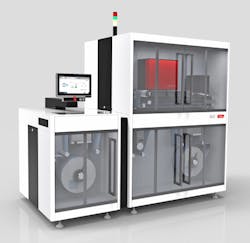Responding to evolving track-and-trace legislative requirements impacting the pharmaceutical space, and the need for efficient, flexible production processes, Hapa AG (a Coesia company) announced a new modular in-house inkjet printing machine for any foil or label-printing application.
The Hapa 862 printing system was unveiled at Achema 2015 last week in Frankfurt, Germany, as part of the Zurich-based packaging specialist’s “smart printing for lean packaging” initiative to support changes in the market.
“The industry has gone from mass production twenty years ago to mass customization,” says James MacKenzie, Hapa’s healthcare sales director. “Hapa allows customized packaging at the last minute. It’s modular, scalable, and what I call plug and print.”
To that end, the Hapa 862 is so modular that it allows customer to configure the machine to suit current production needs. Plus additional modules can be added to meet future needs. For example, upgrade modules include unwinder, rewinder, corona treatment station, print-margin detection, label-margin detection, additional pinning station, cameras, and reject station. Each modules is truly plug-and-play with just a simple mechanical and electrical connection required.
Designed for a packaging line operator in mind, Hapa 862 eases the complexity associated with frequent line changeovers, as well as the challenges associated with SKUs and the supply chain. At the heart of the system is a the company’s UV Drop on Demand “redcube plus” printing module which produces high-quality print resolution of 720 dpi in up to four colors, spot or CMYK, at speeds up to 54 meters per minute—easily keeping pace with the fastest packing lines, say company officials.
It can integrate with existing packaging lines in top-or stand-mounted configurations, or it can operate offline as a roll-to-roll machine. The Hapa 862 can also connect with workflow or an ERP system, and, through the company’s integrated multi-touch HMI, the system can send machine data back in real time to improve operational efficiency.
By printing in-house, pharmaceutical manufacturers have greater control over the process, including the ability to cut waste while allowing material inventory to be reduced by as much as 80% through the use of blank stock.
“It is cheaper to print labels yourself, and getting a new design up and running can theoretically be done in minutes,” MacKenzie says, adding that the challenges of serialization demand the ability to print both standard artwork and variable data in a single pass with high-resolution. With the Hapa 862, customers’ waste and rework levels drop, packaging line yields rise, and improved agility and efficiency lead to savings and growth.
About the Author
Stephanie Neil
Editor-in-Chief, OEM Magazine

Leaders relevant to this article:
